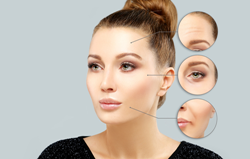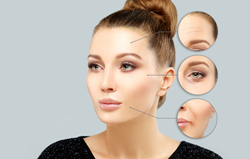[ad_1]

According to Dr. Snodgrass, “ptosis occurs when botox is inadvertently injected into an unwanted area causing the eyelid to droop.
RESTON, Va. (PRWEB)
April 28, 2021
Whitney Buha, a social media influencer from Chicago, has recently gone viral on TikTok for a rare complication she experienced following botox injection. Unfortunately for Buha, after injection, one eye was starting to droop while the other eye was wider than normal. Buha followed up with her injector who placed more Botox in the lower eyebrow in an attempt to counteract the eyelid droop, but this only created further eyelid drooping. The reason? Her injector placed the Botox in the wrong area around the eye, resulting in a facial asymmetry. Our expert injector and board-certified Dermatologist, Dr. Alexandra Snodgrass, from the Naderi Center for Plastic Surgery & Dermatology weighs in on the issue.
According to Dr. Snodgrass, “ptosis occurs when botox is inadvertently injected into an unwanted area causing the eyelid to droop. This occurs more frequently in the hands of an inexperienced injector.” Droopy eyelids, also known as eyelid ptosis, can occur when injected Botox migrates from an area of treatment (usually between the eyebrows) into the levator muscle, the muscle in charge of keeping the eyelids in their normal position. Dr. Snodgrass says that temporary paralysis of this muscle results in the inability to lift the eyelid properly.
What is the best way to avoid botox migration and eyelid ptosis? Well, it is very important to go to an experienced injector who has extensive knowledge of facial anatomy, says Dr. Snodgrass. She explains that “the rate of this complication is extremely low according to studies (5%) and much of that is attributable to inexperienced injectors.” In the hands of an experienced injector, Dr. Snodgrass says the risk of this complication drops to 1%. Dr. Snodgrass adds that she avoids this complication through “careful pre-treatment analysis of each patient, noting any pre-existing asymmetries and pre-treatment muscle movement and tone.” Dr. Snodgrass continues to say that proper injection depth and position with each procedure is critical to minimizing the risk of inadvertent diffusion of neuromodulators. Dr. Snodgrass also notes the importance of, in some cases, treating the glabella and forehead together, as these muscles work in synchrony and disruption of their balance can lead to unwanted outcomes like ptosis.
However, as with any procedure, rare complications from Botox like ptosis can occur even with proper injection placement and dose. Fortunately, Dr. Snodgrass says that multiple treatment options are available for this dreaded complication and that muscle stimulation (mechanical or electrical) and apraclonidine eye drops are the most common treatments. Furthermore, Dr. Snodgrass explains that even without treatment, lid ptosis tends to resolve spontaneously at around 4-6 weeks.
The Naderi Center is truly the most specialized and unique plastic surgery & dermatology practice in the United States.
If you would like more information on about this topic, please call us at (703) – 481- 0002 or email staff@nadericenter.com
Share article on social media or email:
[ad_2]

